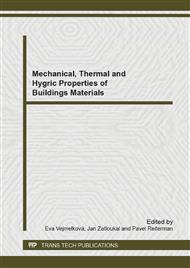[1]
Gawlicki M, Gypsum – another approach, Cement Wapno Beton. 13/75 (2009) 86-96.
Google Scholar
[2]
Degirmenci N, Utilization of phosphogypsum as raw and calcined material in manufacturing of building products, Construction and Building Materials, 22 (2008) 1857-1862.
DOI: 10.1016/j.conbuildmat.2007.04.024
Google Scholar
[3]
Tesárek P, Drchalová J, Kolísko J, Rovnaníková P, Černý R., Flue gas desulfurization gypsum: Study of basic mechanical, hydric and thermal properties, Construction and Building Materials 21(2007) 1500-1509.
DOI: 10.1016/j.conbuildmat.2006.05.009
Google Scholar
[4]
Cherki, A, Remy, B, Khabbazi, A et al., Experimental thermal properties characterization of insulating cork-gypsum composite, Construction and Building Materials 54(2014) 202-209.
DOI: 10.1016/j.conbuildmat.2013.12.076
Google Scholar
[5]
Santos AG, PPF-reinforced, ESP-lightened gypsum plaster, Materiales de Construccion 59 (2009) 105-124.
DOI: 10.3989/mc.2009.41107
Google Scholar
[6]
Skujans J, Vulans A, Iljins U, Aboltins A, Measurements of heat transfer of multi-layered wall construction with foam gypsum, Applied Thermal Engineering 27(2007) 1219-1224.
DOI: 10.1016/j.applthermaleng.2006.02.047
Google Scholar
[7]
Colak A, Density and strength characteristics of foamed gypsum, Cement & Concrete Composites 22 (2000) 193-200.
DOI: 10.1016/s0958-9465(00)00008-1
Google Scholar
[8]
Rubio-Avalos, JC, Manzano-Ramirez, A, Yanez-Limon, JM et al., Development and characterization of an inorganic foam obtained by using sodium bicarbonate as a gas generator, onstruction and Building Materials 7/19 (2005) 543-549.
DOI: 10.1016/j.conbuildmat.2004.12.001
Google Scholar
[9]
Matsui K, Ogawa A, Kikuma, J et al., Influence of addition of Al compound and gypsum on tobermorite formation in autoclaved aerated concrete studied by in situ X-ray diffraction, Cement Wapno Beton, SI (2011) 3-6.
DOI: 10.1016/j.cemconres.2011.01.022
Google Scholar
[10]
Svoboda L. SOVA 1. 0 [online], http: /people. fsv. cvut. cz/~svobodal/sova/, 2014-05-05.
Google Scholar
[11]
ČSN EN 13279-2 Gypsum binders and gypsum plasters Test methods (2005).
Google Scholar
[12]
Roels S, Carmeliet J, Hens H, Adan O, Brocken H, Černý R, Pavlík Z, Hall C, Kumaran K, Pel L, Plagge R. Interlaboratory comparison of hygric properties of porous building materials. Journal of Thermal Envelope and Building Science 27 (2004).
DOI: 10.1177/1097196304042119
Google Scholar
[13]
http: /www. xella. cz/html/czk/cz/ytong-presne-tvarnice. php, 2014-05-05.
Google Scholar


